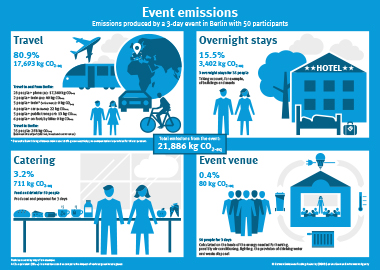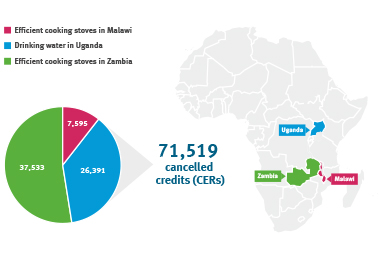Footprint of a Council Presidency

An EU Council Presidency also leaves a CO2 footprint with its events, especially through travel to and from various meetings or by the on-site catering. Germany organises its Presidency in a sustainable way by avoiding emissions in the first place, then secondly by reducing them as far as possible. For example, the German Council Presidency will avoid small gifts and will ensure that catering is based on regional and fair-trade food, which should mainly be vegetable-based. Nevertheless, emissions cannot be completely avoided due to travel to and from the event or on-site activities in the conference building. Therefore, in a final step, Germany offsets the remaining emissions. The total amount of emissions for the German EU Council Presidency has been estimated in advance at 71,519 tonnes of CO2eq. As a sample event in the figure shows, most emissions come from the participants’ travel.
Further information
Germany’s Presidency of the Council of the European Union: Together for Europe’s recovery
Our goal
Our goal is to directly offset any climate impact caused. The principle of offsetting is based on the idea that for the climate it mostly does not matter where emissions are emitted or avoided. Emissions caused in one place can be offset in a different distant place via additional proven emission-saving climate protection projects. To this end, Germany acquires emission reduction credits from ambitious projects that are certified under the Clean Development Mechanism (CDM) of the Kyoto Protocol in accordance with UN rules. Earnings from the sale of credits are used to finance high-quality climate protection projects which, in addition to a proven reduction in emissions, make a special contribution for sustainable development in the host country.
Offsetting is voluntary for Germany – no Presidency is obliged to carry it out. Germany therefore assumes an additional responsibility here and, in continuation of corresponding approaches by other Presidencies, makes its own individual contribution towards climate protection. Conscientiously implemented offsetting will strengthen the international approach to effective climate protection. In addition, Germany is sending an important signal to other players to raise awareness of climate protection issues, to sharpen measures to avoid emissions and to raise awareness of the financial consequences of one’s own actions.
Selecting the climate protection projects
For the Council Presidency’s offsetting, Germany uses climate protection projects from the CDM as this is a market instrument developed and independently monitored at the United Nations level. In order to be registered as a CDM project, climate protection projects must undergo a scrutinising assessment in accordance with the rules and institutions of the Kyoto Protocol of the United Nations Framework Convention on Climate Change (UNFCCC). For this purpose, the projects are checked for their quality by independent experts and approved by a UN Executive Board. The amount of emission savings achieved will only be determined after the project has actually been implemented and has been regularly reviewed by independent experts during the project’s life. Germany purchases one credit per tonne of CO2eq emitted and cancels the credits immediately after acquiring them. This ensures that the offsetting is permanent since further use of the credits is excluded after deletion.
In addition to the CDM rules, Germany ensures that other criteria are also observed to support particularly suitable projects. The impact of climate protection projects should go beyond a mere CO2 reduction and they should have an additional sustainable added value for the project countries – known in the literature as co-benefits. These include, for example, the protection of other environmental media – such as air, soil or water –, resource protection, the expansion of rural electrification, more local jobs or health protection for the local population.
Germany also focuses its attention on small projects and bundled micro-projects as their cost structure puts them at an economic disadvantage compared to large projects. While project development costs are generally high, small and micro projects typically only generate lower revenues from the smaller number of credits sold than can large projects. However, small projects have numerous co-benefits and thus make a direct contribution towards local sustainable development. Regional labour markets are strengthened when new jobs or additional sources of income are created for instance, in the production, distribution and maintenance of efficient cooking stoves or by purchasing crop residues that were not previously used.
Further Information
United Nations Project Mechanisms
Details of the climate protection projects

All selected projects are bundled micro projects (Programme of Activities, PoA) and are located in three of the Least Developed Countries (LDC) in the world. The German Federal Government has acquired and cancelled CERs for a total of 71,519 t CO2.




